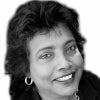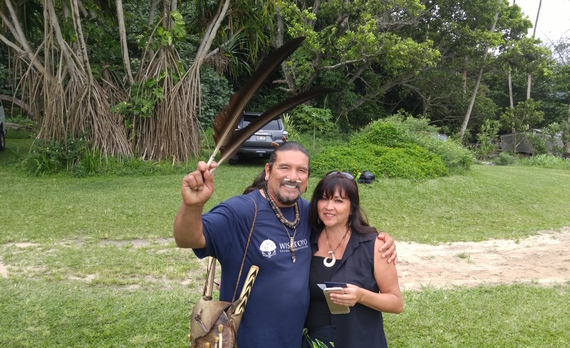With the Ko'olau mountains behind them and the ocean before them, indigenous leaders working on issues vital to the health of their communities introduced themselves to each other. They were assembled at Huilua Fishpond at Kahana State Park on Oahu as part of the Global Gathering organized by KUA Hawai`i on behalf of E Alu Pū. The network's name speaks to its mission: to move forward together, as a school of fish would. And it was with that aim, of drawing strength from shared experience, that E Alu Pū , itself a network of more than 30 communities across the Hawaiian islands, put out a global kāhea (call) for a pre-World Conservation Congress gathering of grassroots indigenous activists.

The struggle takes time. President of Hui Maka'ainana O Makana, Presley Wann (center) thinks in terms of the generations to come. It took 20 years to win acceptance of the Ha'ena Community-Based Subsistence Fishing Area (CBSFA) management plan.
Enthusiastic response from around the globe
"The response outstripped our expectations, " said Kevin Chang, Executive Director of KUA Hawai`i. "Clearly, what we are doing here in Hawaii, tapping into the legacy of our ancestors, training the next generation to take on the responsibility of stewardship -- that's something others around the world are doing too. We have much to learn from each other."
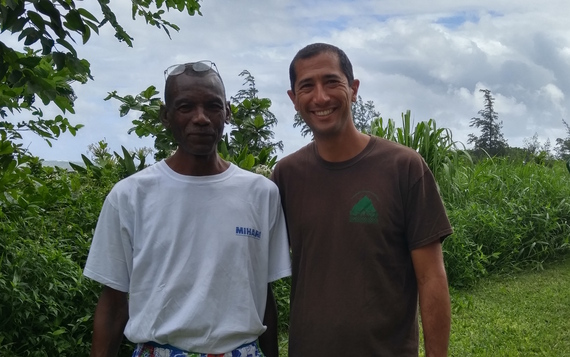
The gathering attracted grassroots organizers from around the world. Seen here, Erik Alson of the MIHARI Network from Madagascar (left), with Kawika Winter Ph.D., Director, Limahuli Garden and Preserve, National Tropical Botanical Garden on Kaua`i.
Some of their words were lost to the wind, but on this overcast Tuesday morning, as they prepared to lend their energies to the ongoing work of restoring Huilua fishpond, it was clear how the group was centering itself. One by one, they spoke from the heart, invoking the wisdom of their ancestors and the ethos of the places near and distant that they had travelled from. They spoke of the spirit that moves them to nurture the land and the oceans, the 'āina. "'Āina means life in Madagascar," said Eric Alson of the MIHARI Network. Alson, a teacher, described himself as a friend of trees and the birds. "I teach in the city, but I live in the country. It's peaceful," he added.
Peace and ʻāina momona, an ecology of abundance for all: we owe that to the next generation, they all seemed to say, in one way or another. Solomon Kaho'ohalahala, a member of the E Alu Pū network, said he draws on his ancestors so that he may do right by his grandchildren. "We are doing this for their future," he said.
"We may never see that future, but we work towards it for their sake," said Mati Waiya, Founder/Executive Director of the Wishtoyo Chumash Foundation in California, seen above with Luhui Isha, Cultural Resources and Education Director of the Foundation. They found plenty of common ground in their conversation with Greg Jacobs, Tribal Administrator from the Coharie Intra-Tribal Council Inc in North Carolina.
Native leaders replace tree-huggers
Each had stories to tell of how the struggle of indigenous peoples has evolved over time. "It used to be that someone would hug a tree and think that made them an expert," said Waiya, not entirely intending to be funny. "Others spoke for us. Today, we find our young people coming to us feeling empowered. They understand that cultural stewardship is our birthright. It is who we are as a people. It is what we are called to do. It is important that we have native peoples leading the way. We are not environmentalists. We are cultural practitioners. We must make our voices heard."
"We are seeing gathering momentum in the way tribal voices are being raised around the world," said Isha. "Both native peoples and non-natives who understand that the life of the planet is at stake, are coming together," she said. "Look at what is happening at Standing Rock. Native peoples have repeatedly had land and water taken away from them so corporations could prosper. That must stop."
"Our young people are key to stopping this kind of behavior. They will change the world," said Waiya. An early member of the Waterkeeper Alliance, Waiya pointed to their strong support of the Sioux nation's efforts to stop the Dakota Access pipeline that threatens their land, water, public health, and tribal rights.
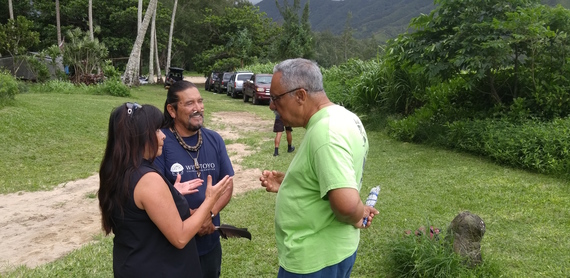
Greg Jacobs (right) describes how the Coharie River Project is empowering the next generation in North Carolina.
Jacobs agreed, recounting how in North Carolina, young people and veterans are getting involved in the Great Coharie River Initiative (GCRI) and how they are drawing strength and a sense of empowerment from it. This is a project by the Coharie People to regain access to lands once managed by tribal families and restore the ability to travel fish, and hunt along a river system that is now clogged. They believe that in working to reverse an environmental disaster they will also revitalize a valuable young tribal population.
Simpler permitting process for fishpond practitioners
Suzanne Case, Department of Land and Natural Resources (DLNR) Chair who joined the group for their workday at the Huilua Fishpond, celebrated the spirit of community at the global gathering. She also unveiled a new guidebook on fishpond restoration, released to coincide with the IUCN World Conservation Congress 2016.
"This guidebook marks the beginning of what we hope will be a new day in Hawaiian fishpond revitalization," she said.

Clutching the newly released guidebook, Leimana Naki from Molokaʻi gives DLNR Chair, Suzanne Case a big hug.
Case recognized the work of all those who contributed to the creation of the guidebook. Fishpond practitioners formed Hui Malama Loko I'a to leverage their skills, knowledge and resources. This network currently includes over 38 fishponds and complexes, with over 100 fishpond owners, workers, supporters and stakeholders. Thanks to their collaborative work with the DLNR Office of Conservation and Coastal Lands (OCCL), a master permitting process and program called "Ho'ala Loko I'a" was created that is in compliance with as many federal and state regulations as possible. This makes the permitting process easier for everyone.
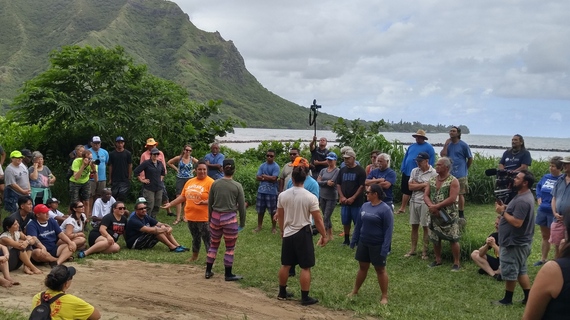
A little coaching from Kahiau Wallace (in orange) of Hō'ala 'Āina 'Kūpono before the group heads to the water for a few hours of fishpond restoration work.
The Huilua Fishpond workday was led by Kahiau Wallace, Board Member of Hō'ala 'Āina 'Kūpono whose family has lived in the ahupua'a of Kahana for generations. "From the time I was a little girl, my parents and grandparents taught me that this is my kuleana: to protect and look after this place. That is what I am doing. And I am so happy to be here with the manaʻo of so many people and their ancestors to help us."
And with that she led the group to the water.
